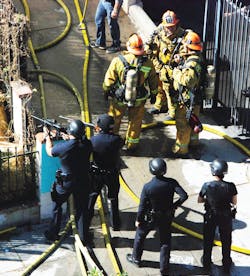Disaster Response: Current and Emerging Threats in Mass Shooting Events
Mass shootings. Active shooters. Mass violence. Responding firefighters, rescue teams and EMS personnel must be aware of the nature of these incidents and how to respond safely and effectively.
The paradigm has certainly shifted for fire/EMS, making it crucial to be prepared to respond to mass-violence incidents. Regardless of where you work, you and your agency will likely face the challenge of responding to incidents that may include acts of large-scale violence toward civilians and acts of violence towards responders. These can and do occur in urban, suburban, metro and rural settings. In fact, typically these incidents occur in small to midsize communities. These responses will require an immediate joint response, including law enforcement, fire and EMS. This same information could be applied toward a terrorist-type event. At such hostile incidents, it is essential that law enforcement, fire and EMS personnel work together.
Scene size-up
Upon arrival at any high-impact incident such as a mass-shooting/active-shooter emergency, it is important to conduct a quick “windshield survey,” even when a scene is believed to be secure. It is always important to gain as much pre-arrival information as possible and listen for key verbal indicators and intelligence that may come across as indicators for a large-scale incident, such as victim numbers and types of injuries. Dispatch information may not always be correct or may be vague based on the information the communications center is receiving.
Any type of mass-violence incident should raise a RED FLAG for all responders to be more aware of what is occurring prior to and during their response. For fire-EMS agencies, typical procedures require that law enforcement be dispatched to any type of incident with a potential for violence, but you may find yourself on such a scene due to a wrong address, victims approaching you or just a sudden discovery or incident eruption.
The first indicators of a possible mass-violence situation will be provided during your dispatch and accompanying pre-arrival information. Location, number of victims and injuries and other updates will also provide responders with the initial indicators of a possible mass-shooting incident. If possible, scan the area using binoculars, spotting scopes or vehicle-mounted cameras before approaching the scene.
Command and control
The Incident Command System (ICS) and Unified Command (UC) are among the best tools for agencies to use when responding to these types of mass violence incidents. There is tremendous need for a rapid and coordinated effort among all agencies to ensure a safe and effective response.
You will also need to direct arriving units and designate at least one or more staging areas, as this will provide you with better accountability of incoming units, better command and a running tally of the number of available fire, EMS and law enforcement units. Immediately request partner agency representatives to the command post to start building the (UC. It would be counterproductive and a serious safety risk to the response for there to be two or more command posts scattered across the incident.
To maintain situational awareness, the command staff should monitor radio traffic and other communications to be aware of other similar situations or incidents occurring. If the incident area is large, such as a college campus, business complex or shopping mall, divide the location into branches or divisions to make the scene more manageable.
On-scene operations
First-arriving units will have a dramatic effect on the progress of the incident. Responders must quickly and safely conduct the initial scene size-up, or “windshield survey.” This may be difficult to do as there may be numerous casualties on scene who need immediate extraction and care. One option may be to declare portions of the scene secure enough that armed law enforcement officers can escort fire and EMS personnel to those locations for immediate size-up, victim care and extraction.
Plan on a large and immediate media response and a similar large and immediate response by parents, family and friends to the incident scene. The media can and must be addressed by quickly designating a public information officer (PIO) and a joint information center (JIC) as the situation grows. With the growing use of “social media” technology, it is critical to put a PIO forward as soon as possible. This will be an important tool to provide information to the public and those in the impact area. Consider multiple staging areas depending, on the number of resources responding to the scene and your “span of control.”
Staging, command, triage and treatment areas may have to initially be located a half-mile or even a mile from the scene due to the distance a round fired from a weapon can travel if the incident is continuing to unfold. Once the scene is under control, these resources can be deployed closer to the incident site for better command and control.
The current fire and EMS standard for response to any active-shooting/mass-violence incident is to stage until the scene is secured by law enforcement. During a common incident involving a shooting or stabbing, securing the scene may take only a few minutes. During a mass-violence/active-shooter incident, however, it may take law enforcement several hours to secure the scene. During this time, injured victims are not receiving medical care or medical support is limited. This requires a different approach for victim approach, care and rescue. Fire and EMS personnel may enter the scene only if it is confirmed that all suspects are confined or neutralized and even then only with armed law enforcement escorts. Only a small number of fire and EMS personnel should enter under these circumstances and additional law enforcement officers should ensure their safe passage.
EMS considerations
APPROACH THE SCENE CAUTIOUSLY! EMS agencies must develop standard operating guidelines (SOGs) for responding to potentially violent situations. Rapidly establish a unified command post with the other responding agencies and staging areas outside of the hazard area AS SOON AS POSSIBLE. Start building the IMS as soon as possible.
Anticipate that law enforcement will assume the lead UC position during the tactical phase of the incident until the scene is secured, but this still requires EMS assistance and guidance in the command post. There may be resistance toward establishing a UC setting initially. Deploy trained and equipped medical personnel to assist in rapid deployment and downed-person extractions in the “hot zone” when possible.
It would be extremely difficult and dangerous to assign an untrained and unequipped EMT or paramedic to enter an active-shooter scene with law enforcement if the agencies have not trained on this together. EMS may need to use “scoop-and-run” and “load-and-go” tactics from the immediate incident scene with law enforcement escorts to a safe area or triage site.
Fire and EMS personnel should remain in unsecured areas with law enforcement escorts only as long as necessary to perform their duties or extract victims to a casualty collection point (CCP). These points may be established in safe areas inside a structure or outside in an open area. Quickly evacuate the wounded to an area of safety as soon as the tactical situation allows. Tactical medics may be the only medical staff available to provide medical care in a hazardous environment or the “hot zone” of an incident. EMS may need to implement disaster procedures such as triage, triage tags, CCP and field treatment areas for minor injuries.
Quickly remove victims from the danger area, and render aid in secure locations. Conduct triage outside the hazard area when possible. Triage may be conducted multiple times on the scene. Use litters, blankets or backboards to quickly remove victims from the danger area. Consider means other than bulky stretchers to remove the victims from the danger area. All responders on the scene must wear appropriate high-visibility identification such as department or command position vests for ease of identification and scene security.
When volunteer or combination fire and EMS departments are involved in a response, some personnel may respond in plain clothes, so they must have proper identification. Fire and EMS personnel should wear helmets and clearly marked fire or EMS jackets. Also be aware of the possible presence of improvised explosives devices (IED) and/or incendiary devices in questionable surroundings. It is important to remember that at hostile incidents, it is essential that law enforcement, fire and EMS personnel can work together safely.
Summary
1. Fire/EMS agencies nationally must conduct tabletop exercises and other types of training on these types of events.
2. A strong command presence will be required during the incident integrating with law enforcement in a UC setting. There may be resistance to this effort.
3. Training on rapidly removing or casualties from danger areas using other means besides heavy ambulance stretchers with law enforcement escorts.
4. Every responder should have training on “self-aid/buddy-aid” medical care for the “hot zone.”
It is vital that law enforcement, fire, EMS and emergency management personnel and administrators train and plan together for these types of incidents. Discussions with all law enforcement, fire, 911, emergency management, EMS and other first response agencies serving the jurisdiction must take place before an incident occurs. Establish common expectations and understandings of what each agency will do and what support each will need from the other agencies.
Realistic guidelines and models are available to help your department develop policies, procedures and training for responding to mass-violence incidents. These include documents and guides developed by the National Fallen Firefighters Foundation (NFFF) and available at http://www.everyonegoeshome.com/index.html. Another resource is The Committee for Tactical Emergency Casualty Care (C-TECC). The committee was convened to speed the transition of military medical lessons learned from the battlefield to civilian crisis response in order to reduce preventable causes of death in both our first-responder and civilian populations. This information can be found at http://c-tecc.org.
Start working now with your departments and local law enforcement agencies to establish these relationships and start building the policies, procedures, and training.
AUGUST VERNON is the Operations Officer for the Forsyth County, NC, Office of Emergency Management. He has been employed in emergency management for 14 years and also served in the U.S. Army as a Chemical, Biological, Radiological and Nuclear (CBRN) Operations Specialist. Vernon teaches courses in Mass Violence/Mass Shootings, Incident Management, Emergency & Crisis Management and Terrorism Planning & Response. He is the author of the First Responders Critical Incident Field Guide, published by Red Hat Publishing.
About the Author

August Vernon
AUGUST VERNON is the operations officer for the Forsyth County Office of Emergency Management in Winston-Salem, NC. He served in the U.S. Army as a chemical, biological, radiological and nuclear (CBRN) operations specialist. He is a writer and member of the International Fire Service Training Association (IFSTA) WMD/Terrorism Committee. Vernon is the author of the new First Responders Critical Incident Guide published by Red Hat Publishing.
